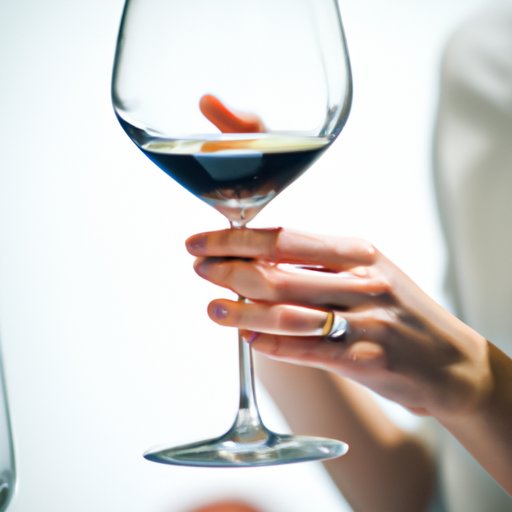
Introduction
Have you ever found yourself at a wine tasting event or dinner party and felt like you weren’t quite sure how to hold your wine glass? Believe it or not, the way you hold your glass can affect the wine’s temperature, aroma, and overall taste. In this article, we’ll cover the basics of holding a wine glass, factors that can affect how you hold it, wine glass etiquette, and even some advanced techniques for a truly immersive wine-tasting experience.
The Basics of Holding a Wine Glass
When it comes to holding a wine glass, there are two primary things to consider: the grip and the position.
The grip is arguably the most important aspect of holding a wine glass. You want to hold the glass firmly enough so that it doesn’t slip out of your hand, but not so tight that you leave visible fingerprints on the glass. Mastering the proper grip can take some practice, but it’s essential to prevent any spills or mishaps.
The position of the glass in your hand is also important. It’s best to hold the glass by the stem so that you’re not transferring heat from your hand to the wine. When you hold a wine glass by the bowl, you increase the wine’s temperature, which can ultimately impact its flavor and aroma in a negative way.
When finding your own comfortable grip for a wine glass, experiment with different placement of your fingers on the stem. Some people prefer to place their thumb and index finger at the base of the stem, while others prefer to wrap their entire hand around the stem. It’s simply a matter of what feels most comfortable to you.
Factors that Affect How You Hold a Wine Glass
The size and shape of the wine glass can also affect how you hold it. For example, holding a champagne flute requires a different technique than holding a standard wine glass with a stem. A stemless wine glass may also require a different grip compared to its stemmed counterpart because the lack of a stem changes the overall balance of the glass. It’s important to be mindful of each glass’s unique characteristics and adjust your grip accordingly.
Here are some tips for holding different types of wine glasses:
- Flutes: hold the glass by the stem and use your thumb and index finger to cradle the base of the bowl gently.
- Stemless glasses: hold the glass by the bowl or on the base of the glass to maintain balance
- Red wine glasses: hold the glass towards the base of the stem as red wine is generally served at a warmer temperature
- White wine glasses: hold the glass higher up the stem as white wines are typically served chilled
Wine Glass Etiquette
When it comes to wine glass etiquette, there are a few common faux pas to avoid besides holding the glass by the bowl. One of the most significant no-no’s is sticking your fingers inside the glass while holding it. This not only makes the glass look unprofessional, it can also smudge the glass and affect the temperature of the wine. Additionally, overfilling the glass is also a common mistake to avoid. Leave some room at the top of the glass, so you can swirl the wine without spilling it.
It’s essential to be aware of wine glass etiquette in a variety of social situations, such as business dinners, formal events, casual gatherings, and wine tastings. In more formal settings, it’s generally expected that you hold the glass by the stem, while in more casual settings, it’s acceptable to hold the glass by the bowl. Adapting to your environment is critical to avoiding any embarrassment or social awkwardness.
Advanced Techniques for Holding a Wine Glass
If you’re ready to take your wine-tasting skills to the next level, there are advanced techniques you can use to enhance your overall experience. For example, holding the glass at a 45-degree angle can help aerate the wine and intensify its flavor and aroma. You can also use specific finger placement techniques, such as using your pinky and ring finger to support the base of the stem while holding the glass so that your other fingers don’t interfere with the wine’s aeration.
Another essential technique of wine tasting is swirling and sniffing, which allows you to experience the full range of flavors and aromas of the wine. Swirling the wine aerates it and releases its fragrance into the atmosphere. After swirling, place the glass under your nose and inhale gently. Take note of the wine’s fragrance before taking a careful sip.
Conclusion
To sum it up, holding a wine glass properly is more crucial than one may think. With the right grip, the correct position, and understanding of wine glass etiquette, you can maximize the overall wine-tasting experience. By experimenting with advanced techniques, you can enhance the full range of flavors and aromas that wine has to offer.




